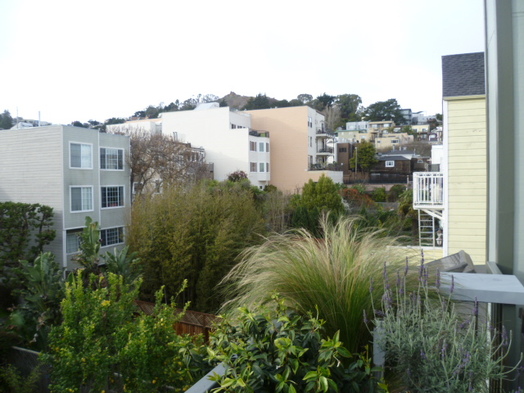 View from balcony at my Buddy and Orie's place in the Castro.
View from balcony at my Buddy and Orie's place in the Castro. There are few cities where I feel as good and at home as San Francisco. The city justifiably has important symbolic value throughout the world as a bastion of individual freedom and human dignity, and this is undeniably a desirable feature of life in this area. The Bay Area, San Francisco's region, is my favorite part of the United States. I lived in the East Bay (Berkeley) over 10 years ago while in grad school, and I never forgot the unique feel to this area. The climate is mild, the vegetation is Mediterranean, the people are generally tolerant and open-minded, and there's simply a spontaneity and sense of possibility in the air here. Most residents wouldn't think of living anywhere else.
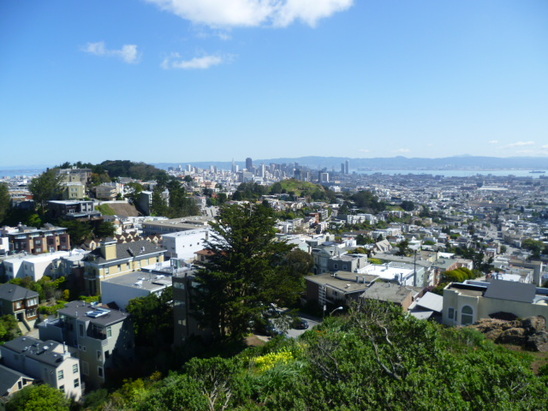 View from Corona Heights Park
View from Corona Heights Park This city is no earthly paradise, although it has an incredible charm and many attractive attributes. But its global reputation and image are bound to disappoint on closer examination, as many foreign visitors have told me. This extremely expensive city has seriously rough edges that drag down its quality of life in multiple ways. Despite being virtually the wealthiest large city in the United States, it often has a ramshackle, dirty and run-down look to it. This shabby appearance comes as a surprise to many visitors from abroad who expect more from this legendary city. In fact, in the face of incredible natural advantages, a highly educated population and wealth, it settles for a second-rate quality of life for the bulk of its inhabitants. Yes, I did say San Francisco has a second-rate quality of urban life. In this blog posting I will explain my view. Brace yourself as I dig further into the pathologies of American cities.
But first a little glimpse of beauty from this city (it is rich in beauty like this), to highlight the shame of allowing so much of it to be so mediocre.
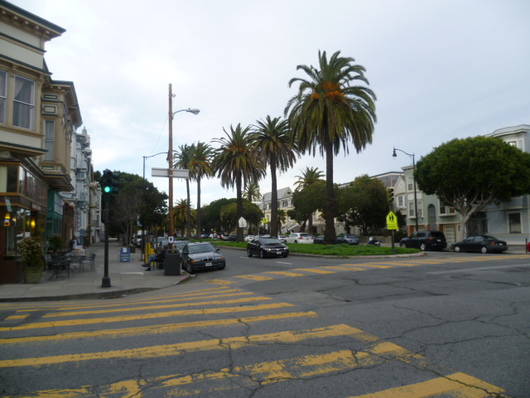 A typically weary-looking street surface near the Castro (Dolores and 18th, I think).
A typically weary-looking street surface near the Castro (Dolores and 18th, I think). I am rather astounded at the general public's apathy in the face of our country’s shamefully ill-maintained infrastructure. I'd expect outrage, really. Perhaps Americans have gotten used to this state of affairs, and don't know what quality public infrastructure looks like in other wealthy countries around the world.
This rough infrastructure is, in fact, one of the things most characteristic of American cities. San Francisco is no exception, and a walk around this city can be a big surprise to visitors from northern Europe, Japan or Australia. Things are simply not well maintained, or maintained in a manner fitting a poor, developing world city, not one of the wealthiest and potentially most beautiful cities in the world. Sidewalks and streets are haphazardly patched, public transport is rough, and city parks are often in poor condition.
The poor infrastructure of this city is highlighted by the liberal use of cement, frosting all surfaces often without leaving any space for trees and vegetation or other features. Although San Francisco is politically 'green', the city itself is in desperate need of more trees. SF ranks 17th of the 20 largest cities in the US in terms of its urban forest and in terms of street trees, I'm sure it must be at the absolute bottom. Many, if not most, streets of San Francisco are uninviting urban deserts, despite enjoying an exceptionally good climate. Below are a sampling of San Francisco's cement-covered and lifeless streets.
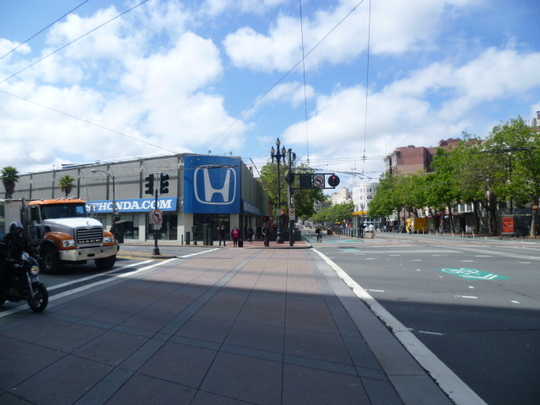 Ramshackle Market Street, one of San Francisco's main arteries.
Ramshackle Market Street, one of San Francisco's main arteries. For most of the world's urban history, cities and streets were built on a human scale. Streets in older cities around the world tend to be relatively narrow, and these streets seem in scale with the buildings that line them. Americans seem to have forgotten what makes for exciting, engaging and beautiful streets. The key is a profound sense of humanity in design. This is quickly recognizable. Streets and public spaces designed with humanity attract people, not just passers-through, but people who stay for extended periods of time.
Exacerbating the scale issue in San Francisco is what I call a low density of detail in many areas, making streetscapes unappealing and unengaging. Great streets have many details, complex details, providing many reasons to stop and do something, if it only be to sit on a comfortable bench and admire the fine paving stones and beautiful landscaping. This density of features can be called 'friction'. Streets with friction are destinations in and of themselves, places you go to do many things at once (without having to get in your car and go elsewhere) and places that bring people together. San Francisco has many streets like this (for example, Dolores and Mission Streets), of course, but far too many of its streets are rather lifeless. This is a shame, as open spaces in cities are opportunities for the common good and streets are generally the most common open spaces citizens have to enjoy. Streets should be the most important public spaces in a city.
Its easy to see when a street has become a successful public place because it will attract people. Streets that are unsuccessful have few people and are lifeless. Naturally, cities need a full range of street types (including quiet residential streets), but San Francisco has vast wasted street spaces that could instead be alive with street life and business opportunities.
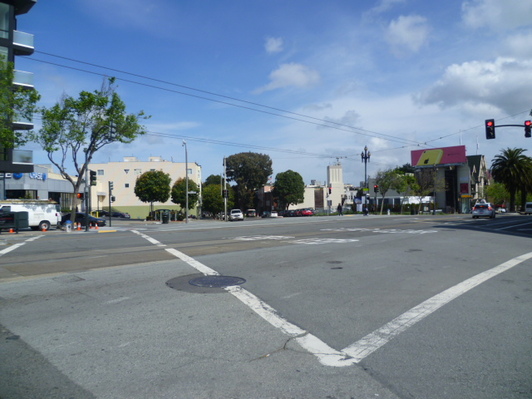
Maybe I should applaud SF for not hiding America's reality of haves and have nots, but still, Market Street is generally not a pleasant place to be, despite its key location running from downtown to the Castro. It should be San Francisco's most vibrant and attractive street, without excuses.
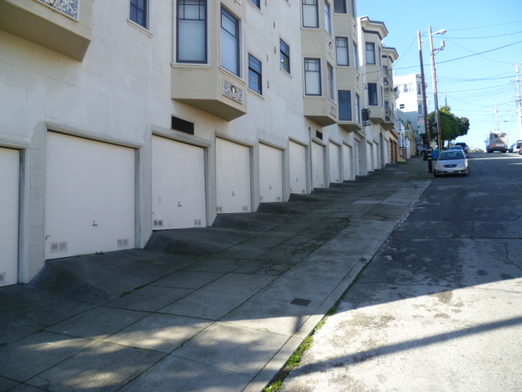 A lifeless San Francisco streetscape characterized by cement and garage doors.
A lifeless San Francisco streetscape characterized by cement and garage doors. In American cities, people on opposite sides of a street are usually separated by wide swathes of fast-moving traffic. Cars, and space dedicated to cars, eat up the bulk of the open space streets provide, Streets are not primarily thought of as places for people to gather and do things, but instead as spaces to facilitate the rapid movement of automobile traffic.
In San Francisco, the car-dominated street design spreads over into the design of sidewalks and buildings to an extent that I have not seen in any other densely populated American city. Despite having decent public transportation within the city (decent, not great), a high proportion of residents of San Francisco have cars and use them to commute, particularly if they work outside of the city. Regional public transit in the Bay Area is inconvenient and expensive.
This reliance on auto transport created a problem: where to park all the cars in this densely packed city. The solution was to build housing with garages on the first floor, in addition to allocating much street space for car parking. A distinctive feature of San Francisco, therefore, is the garage doors facing the streets throughout much of the city, as you can see in the picture above. This proliferation of garages along the city's streets drastically distorts the function of the city's streets by creating dead zones along sidewalks. There is no space for shops or cafes, The streets are bare of trees and vegetation because cars cannot leave garages if trees are planted along the street. The result is an abundance of lifeless and treeless streets that are wholly unattractive and serve no social function.
Allowing car owners to dominate so much of a city's open space is not only detrimental to urban livability, the use of this space by cars costs a city money. A study from Connecticut shows how much allocating and subsidizing parking spots actually costs a city (in the case of Hartford, it comes to about $1,200/year per parking place). In San Francisco's case, as sidewalk and street space in front of the endless garages cannot be utilized for anything else, there is a huge hidden subsidy that must be considered beyond the subsidized street parking the city provides.
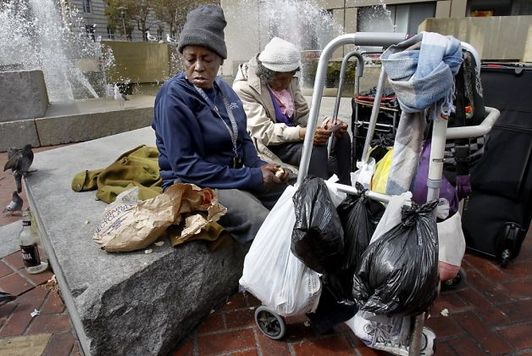 Homeless women in San Francisco (from SFGate)
Homeless women in San Francisco (from SFGate) Riding public transport is another way to come into contact with large numbers of people with serious problems. You simply don't see this kind of thing, on this scale, in other wealthy countries. Crime is also higher than it is in most of Europe, Canada, Australia or Japan.
San Francisco has, it must be said, a very racially and economically diverse population. The varied groups have different needs and interests, and the national and local governments have not been very skillful at managing the situation, resulting in severe problems such as homelessness.
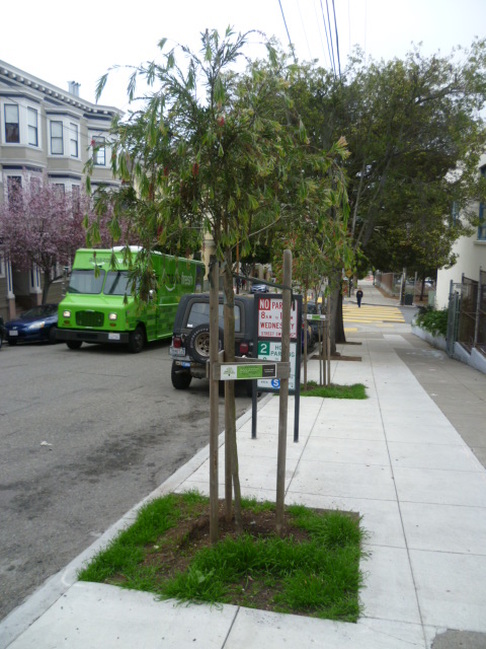 Street trees planted with the help of Friends of the Urban Forest
Street trees planted with the help of Friends of the Urban Forest Some tweaks to the system are underway that will make San Francisco a better city.
For example, an organization called 'Friends of the Urban Forest' (FOF) is helping city residents convert some of that great expanse of concrete in front of their homes into gardens and tree planting spaces. (See picture to right) My friends Buddy and Orie (whose veranda is featured in the first photo of this blog posting) have just participated in a project in their neighborhood with FOF. The results are wonderful. However, like much of the urban improvements going on in San Francisco, projects like this tend to be driven by the educated and wealthy, and are not benefiting all areas equally. I rarely saw urban greening projects in the poorer parts of town.
Another encouraging sign is that the generally rather dreadful Market Street, which I write about above, is undergoing massive development now that will no doubt clean it up and restore some of its traditional role as one of the great streets of San Francisco. New high rises are popping up along several areas of the street, and new shopping and commercial development will follow to bring life back to this area.
Finally, I've just read that a law involved with major urban planning projects is changing in California to be less car friendly. This will allow for public transit projects to get approval more easily and speed up developments such as San Francisco's new bus rapid transit line.
When I look at my pictures from San Francisco, I really miss this city and my good friends there. I'm hopeful that San Francisco will tackle its quality of life issues and move towards a respectable position in the group of the world's most livable cities. It has a long way to go.
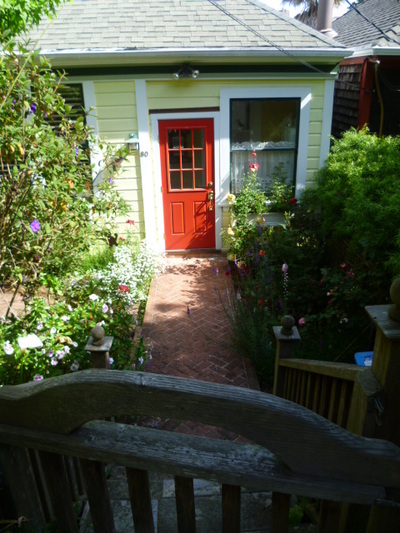
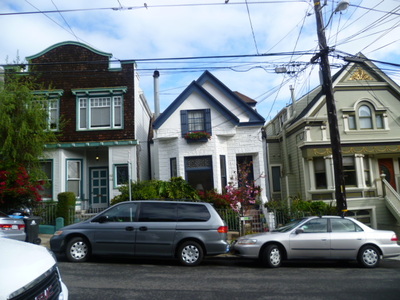
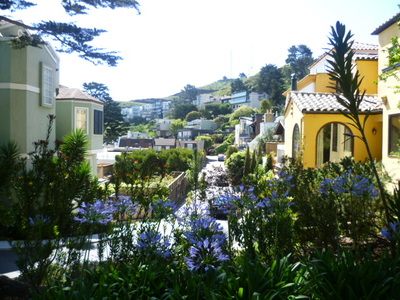
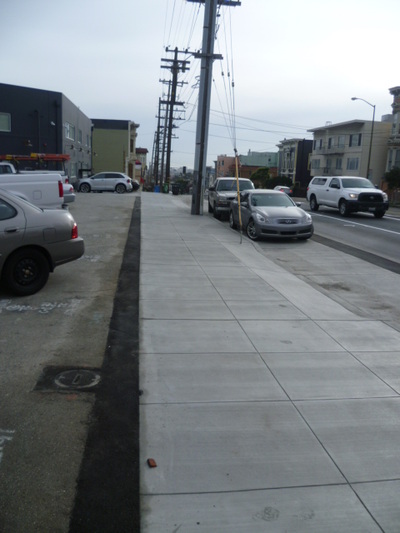
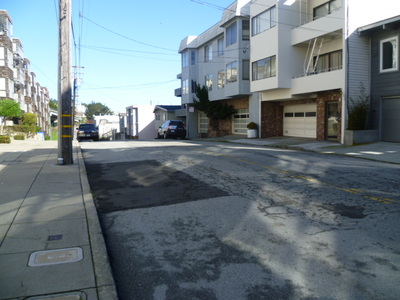
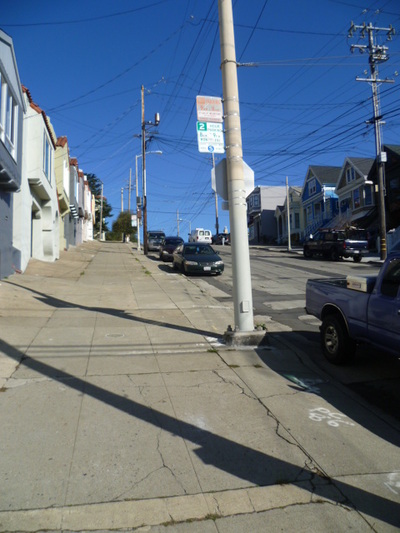
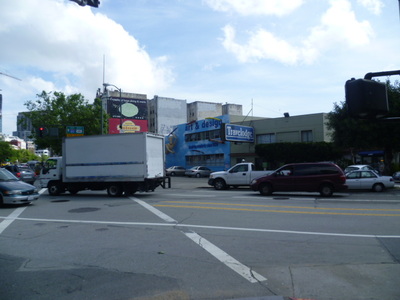
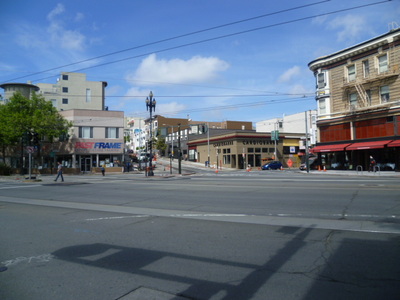
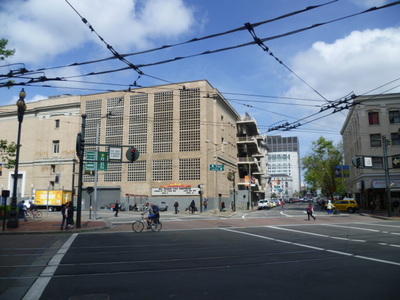

 RSS Feed
RSS Feed

